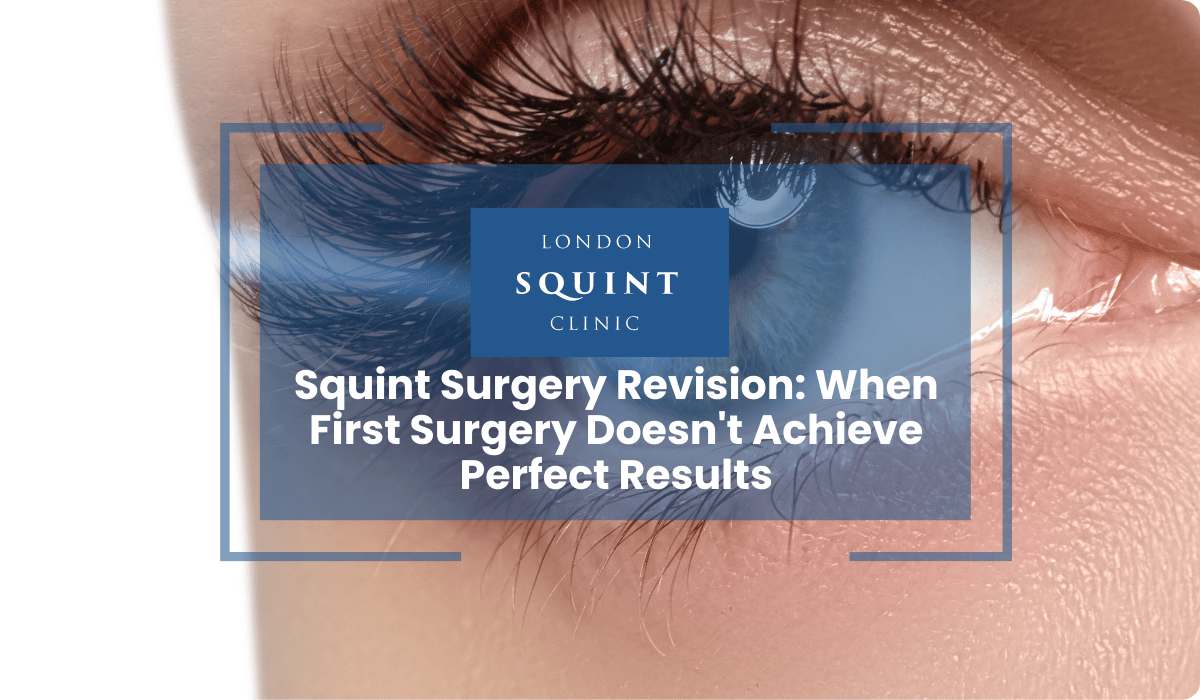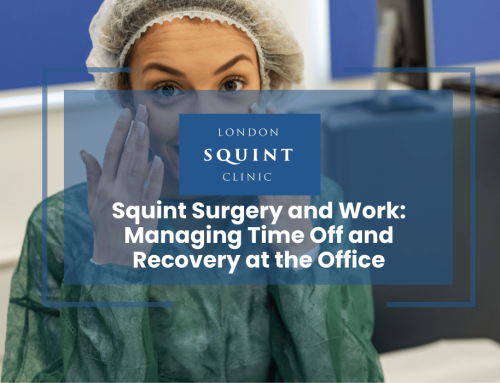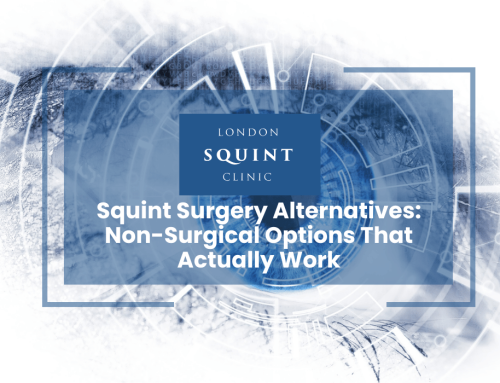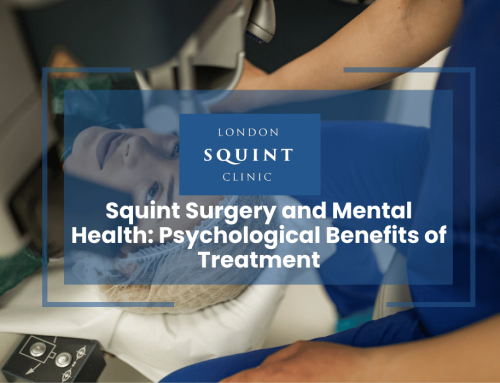Squint Surgery Revision: When First Surgery Doesn’t Achieve Perfect Results
Squint Surgery Revision: Key Considerations
- Squint surgery revision is a corrective procedure performed when initial squint surgery does not fully resolve eye misalignment.
- Signs that may indicate the need for additional correction include persistent eye misalignment, double vision, or unsatisfactory cosmetic results.
- Reasons for incomplete squint correction can include conservative surgical approach, severity of initial misalignment, underlying neurological conditions, or individual healing responses.
- The timing of revision squint surgery depends on factors such as eye alignment stability, patient’s healing process, and surgeon’s assessment, typically requiring a waiting period of a few months to a year.
- Achieving optimal results with revision squint surgery requires surgical expertise, careful planning, and patient cooperation, with a personalised treatment plan tailored to the individual’s needs.
- Alternatives to squint surgery revision, such as prism glasses, botulinum toxin injections, or vision therapy exercises, may be considered in certain cases, but their effectiveness can vary depending on the severity and type of squint.
Here is the blog post content with the requested sections and formatting:
Table of Contents
What is Squint Surgery Revision?
Squint surgery revision, also known as reoperation or second surgery, is a corrective procedure performed when the initial squint surgery does not fully resolve the eye misalignment. This additional treatment aims to further improve eye alignment, reduce residual squint, and enhance the cosmetic appearance of the eyes. Revision surgery may be necessary if the patient experiences undercorrection, overcorrection, or other complications following the first surgery. The goal of revision surgery is to fine-tune the results and achieve optimal eye alignment for improved vision and aesthetics.
Signs You May Need Additional Squint Correction
After undergoing initial squint surgery, some patients may still experience symptoms that indicate the need for additional correction. These signs include persistent eye misalignment, double vision, or unsatisfactory cosmetic results. If the eyes continue to drift inward, outward, upward, or downward following surgery, it may be a sign of residual squint. Patients may also notice that their eyes tire easily or that they have difficulty maintaining proper alignment throughout the day. If these symptoms persist or worsen over time, it is essential to consult with a squint specialist to determine if revision surgery is necessary.
Reasons for Incomplete Squint Correction
There are several reasons why initial squint surgery may not fully correct the eye misalignment. In some cases, the surgeon may have been conservative in their approach to avoid overcorrection, leading to a residual squint. Other factors, such as the severity of the initial misalignment, the presence of underlying neurological conditions, or individual healing responses, can also contribute to incomplete correction. Additionally, the development of scar tissue or changes in eye muscle function over time may affect the long-term results of the surgery. A thorough evaluation by a squint specialist can help identify the specific reasons for incomplete correction and guide the decision-making process for revision surgery.
How Soon Can You Have a Second Squint Surgery?
The timing of revision squint surgery depends on several factors, including the stability of the eye alignment, the patient’s healing process, and the surgeon’s assessment. In general, it is recommended to wait at least a few months after the initial surgery to allow the eyes to settle and heal properly. This waiting period also allows the surgeon to accurately evaluate the results and determine if further correction is necessary. In some cases, patients may need to wait longer, up to a year or more, before undergoing revision surgery. The decision to proceed with a second surgery should be made in consultation with a squint specialist who can provide personalised guidance based on the individual case.
What to Expect During Revision Squint Surgery
Revision squint surgery is typically performed under general anaesthesia and follows a similar process to the initial surgery. The surgeon will make precise adjustments to the eye muscles to improve alignment and correct any residual squint. The specific surgical techniques used may vary depending on the type and extent of the misalignment. In some cases, the surgeon may need to recess or resect the eye muscles, while in others, they may perform transposition or other advanced procedures. The duration of the surgery and the recovery process can vary depending on the complexity of the case. Patients can expect some discomfort, swelling, and redness following the surgery, but these symptoms typically subside within a few weeks. Regular follow-up appointments with the surgeon are essential to monitor the healing process and ensure optimal results.
Achieving Optimal Results with Reoperation
Achieving optimal results with revision squint surgery requires a combination of surgical expertise, careful planning, and patient cooperation. The surgeon will conduct a thorough evaluation to assess the current eye alignment, review the patient’s medical history, and discuss their goals and expectations. This information helps the surgeon develop a personalised treatment plan tailored to the individual’s needs. In some cases, the surgeon may recommend additional tests or imaging to gather more detailed information about the eye muscles and surrounding structures. Patients can contribute to the success of the revision surgery by following pre- and post-operative instructions carefully, attending all scheduled follow-up appointments, and communicating any concerns or questions to their surgeon. With a collaborative approach and realistic expectations, revision squint surgery can help patients achieve significant improvements in eye alignment, visual function, and overall quality of life.
Alternatives to Squint Surgery Revision
While revision squint surgery is often the most effective option for correcting residual misalignment, there may be alternative treatments available in certain cases. These alternatives include the use of prism glasses, botulinum toxin injections, or vision therapy exercises. Prism glasses can help alleviate double vision by redirecting the light entering the eyes, while botulinum toxin injections can temporarily weaken overactive eye muscles to improve alignment. Vision therapy exercises aim to improve eye coordination and binocular vision through a series of specialised activities. However, these alternatives may not be suitable for all patients, and their effectiveness can vary depending on the severity and type of squint. A squint specialist can help determine if these options are appropriate based on the individual case and provide guidance on the best course of treatment. In some cases, a combination of surgical and non-surgical approaches may be recommended to achieve optimal results.
It is important to note that while alternative treatments can be helpful in managing residual squint, they may not provide the same level of long-term correction as revision surgery. Patients should discuss the potential benefits and limitations of each option with their squint specialist to make an informed decision about their treatment plan. Additionally, regular follow-up care and monitoring are essential to ensure that the chosen treatment approach is effective and to address any changes or concerns that may arise over time. By working closely with a skilled squint specialist and exploring all available options, patients can achieve the best possible outcomes and improve their overall quality of life.
Frequently Asked Questions
How long does it take to recover from revision squint surgery?
Recovery time after revision squint surgery varies from person to person, but most patients can expect to resume normal activities within 1-2 weeks. Swelling, redness, and discomfort are common in the first few days after surgery but should subside gradually. Complete healing may take several weeks to a few months, and regular follow-up appointments with the surgeon are essential to monitor progress.
Is revision squint surgery more complicated than the initial surgery?
Yes, revision squint surgery is often more complex than the initial surgery. This is because the surgeon must work with tissues that have already been operated on, which may have scarring or altered anatomy. The surgeon must also carefully assess the current eye alignment and determine the most appropriate surgical approach to achieve the desired correction. However, with the expertise of a skilled squint specialist, revision surgery can still be highly effective in improving eye alignment and visual function.
What are the risks associated with revision squint surgery?
As with any surgical procedure, revision squint surgery carries some risks. These may include infection, bleeding, overcorrection or undercorrection of the squint, and rarely, vision loss. However, these risks are generally low when the surgery is performed by an experienced squint specialist. Patients should discuss any concerns about potential risks with their surgeon before deciding to proceed with revision surgery.
Will I need to take time off work or school after revision squint surgery?
Most patients will need to take some time off work or school after revision squint surgery to allow for proper healing and recovery. The exact amount of time needed will depend on the individual case and the type of work or school activities involved. In general, patients should plan to take at least a few days to a week off and gradually resume normal activities as directed by their surgeon. It is important to follow all post-operative instructions carefully to ensure the best possible outcomes.
How much does revision squint surgery cost?
The cost of revision squint surgery can vary depending on several factors, including the complexity of the case, the surgeon’s experience, and the location of the practice. In general, revision surgery may be more expensive than initial squint surgery due to the added complexity and expertise required. Patients should discuss the estimated costs and payment options with their surgeon’s office before proceeding with treatment. In some cases, insurance may cover a portion of the costs if the surgery is deemed medically necessary.
Can revision squint surgery be repeated if necessary?
In some cases, patients may require more than one revision squint surgery to achieve optimal eye alignment. The decision to perform additional surgery will depend on the individual case and the patient’s goals and expectations. If a patient experiences persistent or recurrent misalignment after revision surgery, their surgeon may recommend further evaluation and treatment. However, it is important to have realistic expectations and understand that multiple surgeries may be necessary to achieve the best possible outcomes. The surgeon will work closely with the patient to develop an appropriate treatment plan and provide ongoing care and support throughout the process.
Find out if you are suitable for Double Vision Treatment
Not everyone is eligible for double vision surgery.
Find out if you could benefit from this life-changing surgery by taking the quick self-suitability quiz below:
Our most popular procedures

Hello, I’m Nadeem Ali
I’m one of the few eye surgeons in the world with 100% focus on Squint and Double Vision Surgery.
I have 24 years of eye surgery experience, and worked for 13 years as a Consultant at London’s renowned Moorfields Eye Hospital.
In 2023, I left the NHS to focus fully on treating patients from across the world at the London Squint Clinic. You can read more about me here.
There’s lots of information on the website about: squint surgery, double vision surgery and our pricing.
The most rewarding part of my job is hearing patients tell me how squint or double vision surgery has changed their lives. You can hear these stories here.
Mr Nadeem Ali
MA MB BChir MRCOphth FRCSEd(Ophth)





